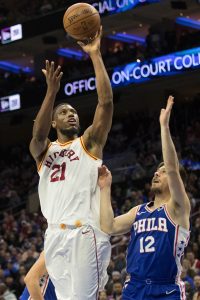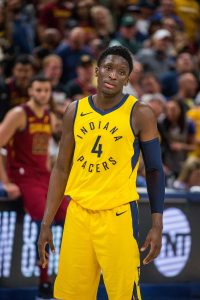The trade that sent Paul George to Oklahoma City in exchange for Victor Oladipo and Domantas Sabonis, widely panned at the time, was the catalyst for the Pacers‘ surprisingly strong 2017/18 season. Although they were unable to knock off the Cavaliers in the first round of the playoffs, the Pacers won 48 regular-season games and then gave LeBron James‘ squad all it could handle in the Eastern Conference quarterfinals.
Having cleverly sidestepped the prospect of a potential rebuild, the Pacers are now in position to keep fortifying an impressive roster, given their cap flexibility.
Here are five key questions facing the franchise this summer:
 1. Will Thaddeus Young opt out of his contract?
1. Will Thaddeus Young opt out of his contract?
The second-highest-paid player on the Pacers’ roster in 2017/18, Young also averaged the second-most minutes per game behind Oladipo, playing an important role in the team’s success. Still, as a frontcourt player who doesn’t protect the rim or make many outside shots, Young probably wouldn’t be one of the league’s most coveted free agents if he opts out of his contract this summer.
Nonetheless, Young is reportedly strongly considering the possibility of declining a player option worth $13.76MM. The veteran forward, who turns 30 on Thursday, may never again have a better chance to land a long-term contract than he does this summer, so even if he has take a pay cut for 2018/19, signing a multiyear deal and receiving some long-term security could be worth it.
Young’s decision will have a significant impact on the Pacers’ cap outlook for next season. If he opts out and doesn’t re-sign in Indiana, the club could potentially double its available cap room, which would create new opportunities in the free agent and/or trade market.
The best outcome for both sides may see Young turn down his player option in order to sign a new contract with the Pacers. For instance, an agreement in the three-year, $30MM range would give Young a good reason to turn down a one-year payday of $13MM+, and it would open up some extra cap space for Indiana this summer.
2. Will the Pacers retain their veterans on partially guaranteed contracts?
The majority of players around the NBA who are on non-guaranteed or partially guaranteed contracts for 2018/19 will earn the minimum salary if they’re retained. That’s not the case for three Pacers veterans, who would make a combined $30.5MM if they stick with Indiana.
Bojan Bogdanovic ($10.5MM) and Darren Collison ($10MM) signed similar two-year contracts with Indiana last summer, and now both look like good bets to return for next season. Bogdanovic only has a $1.5MM guarantee, but he had an excellent year as the Pacers’ starting small forward, averaging a career-high 14.3 PPG and knocking down 40.2% of his three-pointers. At $10.5MM on an expiring deal, he’s a solid value, and the same can be said for Collison, who has a $2MM partial guarantee for now. As Indiana’s starting point guard, he recorded 12.4 PPG and 5.3 APG to go along with a league-leading .468 3PT%.
That leaves Jefferson, who also has a $10MM salary for next season, with $4MM currently guaranteed. Unlike Bogdanovic and Collison, the 33-year-old isn’t a regular rotation player for the Pacers, having established new career lows in minutes in each of his two seasons in Indiana. The Pacers would save $6MM by waiving Jefferson, and I’d be surprised if they don’t take advantage of that opportunity.
It’s possible that the outlooks for these players could change — if the Pacers get a shot at a marquee free agent, perhaps Bogdanovic and/or Collison would need to be waived to create extra cap space. If Indiana needs to reach the minimum cap floor, perhaps Jefferson’s salary will get guaranteed. But for now, the club’s decisions seem fairly straightforward.
3. Will the Pacers make a major splash in free agency or on the trade market?
At the trade deadline, several Pacers players implored president of basketball operations Kevin Pritchard not to break up the squad. Those players argued that the club’s best move would be to stand pat in order to avoid messing with Indiana’s chemistry and success. Pritchard listened, and the Pacers didn’t make a deadline deal.
That anecdote is worth keeping in mind as Indiana considers trade options this summer. Pritchard will probably make a trade or two if the right opportunity arises, but the Pacers are unlikely to overhaul their roster drastically by packaging three or four regular contributors for one standout player. Not after seeing how well this group meshed during the 2017/18 season.
With cap room available this offseason, the free agent market might represent the best path for the Pacers to add another impact player to the mix. However, Indiana typically isn’t a go-to destination for top free agents, and Pritchard’s own comments this spring about the franchise’s aversion to “big names” and “big personalities” suggest the club is unlikely to be in the mix for stars.
The Pacers will do their due diligence on any signing or trade that could increase their ceiling for 2018/19, but it wouldn’t be a surprise if the front office ultimately decides to take an approach similar to last year’s, when multiple free agents joined the team on short-term, mid-level-type contracts.
4. Will Myles Turner be extended?
If the Pacers do explore a blockbuster deal, Turner would make some sense as a centerpiece. He didn’t have the breakout year that many observers expected in 2017/18, and there’s plenty of overlap between him and Sabonis, raising some questions about whether both players have long-term futures in Indiana.
As a 22-year-old big man who can make three-pointers and block shots, Turner would have substantial trade value. He also has tremendous value to the Pacers, which is why there’s a much better chance that the team hangs onto him and attempts to figure out how to best maximize both his and Sabonis’ skill sets.
Assuming Turner remains on the roster, the Pacers will face another decision on him this offseason — is a long-term extension in the cards? Turner will be extension-eligible for the first time between July 1 and the start of the regular season, and this might be the best time for the club to strike. After all, Turner is coming off something of a down season. If he bounces back with a career year in 2018/19, he’ll get even more expensive as he enters restricted free agency.
I expect the Pacers to explore a long-term deal for Turner in the coming months, perhaps even finalizing a deal if the price is right. But with plenty of teams around the league expected to clear cap room for 2019, Turner’s representatives would be smart not to settle for a team-friendly offer in 2018. And if Indiana can’t get a discount, the club is probably best off keeping its options open by waiting until next year to commit to Turner.
5. What will the Pacers do with their first-round pick?
Armed with the No. 23 overall pick, the Pacers have focused primarily on forwards and swingmen in their group workouts leading up to this year’s draft.
It makes sense that the team would be eyeing that sort of player. In Oladipo, Collison, Cory Joseph, and Lance Stephenson, the Pacers have no shortage of ball-handlers in the backcourt, and Turner and Sabonis figure to man the middle. Acquiring a three-and-D small forward to pair with Bogdanovic – or a power forward as Young insurance – seems logical.
Kevin Huerter, Dzanan Musa, Troy Brown, Jacob Evans, Chandler Hutchison, and Keita Bates-Diop are among the prospects who could be options for Indiana at No. 23. Given how sparingly 2017 first-rounder T.J. Leaf was used in his rookie season, the Pacers probably won’t expect an immediate impact from this year’s top pick. That means targeting the player whose long-term outlook they like the best.
Here’s where things currently stand for the Pacers financially:
Guaranteed Salary
- Victor Oladipo ($21,000,000)
- Cory Joseph ($7,945,000): Exercised player option
- Al Jefferson ($4,000,000) — Partial guarantee. Non-guaranteed portion noted below.1
- Myles Turner ($3,410,284)
- Domantas Sabonis ($2,659,800)
- T.J. Leaf ($2,407,560)
- Monta Ellis ($2,245,400) — Waived via stretch provision
- Darren Collison ($2,000,000) — Partial guarantee. Non-guaranteed portion noted below.2
- Bojan Bogdanovic ($1,500,000) — Partial guarantee. Non-guaranteed portion noted below.3
- Ike Anigbogu ($690,000) — Partial guarantee. Non-guaranteed portion noted below.4
- Total: $47,858,044
Player Options
- Thaddeus Young ($13,764,045)
- Total: $13,764,045
Team Options
- Lance Stephenson ($4,360,000)
- Joe Young ($1,600,520)5
- Total: $5,960,520
Non-Guaranteed Salary
- Bojan Bogdanovic ($9,000,000) — Partial guarantee. Guaranteed portion noted above.3
- Darren Collison ($8,000,000) — Partial guarantee. Guaranteed portion noted above.2
- Al Jefferson ($6,000,000) — Partial guarantee. Guaranteed portion noted above.1
- Alex Poythress ($1,544,951)6
- Ike Anigbogu ($688,242) — Partial guarantee. Guaranteed portion noted above.4
- Total: $25,233,193
Restricted Free Agents
- None
Unrestricted Free Agents / Other Cap Holds
- No. 23 overall pick ($1,895,624)
- Trevor Booker ($1,499,698): Non-Bird rights
- Glenn Robinson III ($1,499,698): Bird rights
- Total: $4,895,020
Projected Salary Cap: $101,000,000
Projected Cap Room: $14,602,734
- Our projection accounts for Indiana’s five fully guaranteed salaries, Thaddeus Young‘s player option, full salaries for Bogdanovic, Collison, and Anigbogu, Stephenson’s team option, and cap holds for the first-round pick and one empty roster spot. The result? A total team salary of $86,397,266. However, if Young opts out and/or the Pacers opt to cut more players with non-guaranteed deals, the team could double or even triple its projected cap space.
Footnotes:
- There are conflicting reports on Jefferson’s guarantee date. His salary becomes fully guaranteed after either July 2 or January 10.
- Collison’s salary becomes fully guaranteed after July 1.
- Bogdanovic’s salary becomes fully guaranteed after June 29.
- Anigbogu’s salary becomes fully guaranteed after July 15.
- Young’s salary would still be non-guaranteed until July 1 if his option is exercised.
- Poythress’ salary becomes fully guaranteed after July 25.
Note: Rookie scale cap holds are estimates based on salary cap projections and could increase or decrease depending on where the cap lands.
Salary information from Basketball Insiders was used in the creation of this post. Photos courtesy of USA Today Sports Images.
I think they have to bet on Turner of Sabonis, though both can space the floor cannot see them playing together, so you cannot have them both they should choose 1 & try to get some value trading the other, it’s a shame I like them both.
From a contract standpoint, Sabonis and Turner really shouldn’t have anything to do with one another. Both are on rookie deals, and playing for relative peanuts for the next couple years.
The earlier the Pacers extend BOTH the cheaper the deals are going to be. In turn, that minimizes the risk of being saddled with an enormous untradeable deal.
Extending Turner should be Job 1 for the front office.
There are some good PG in the draft and they should take one. Tough….good defenders….plays hard every minute….Hoosier basketball….Brunson, for instance. Collision is on the back nine…..Lance is risky to count on long term. Go Pacers!